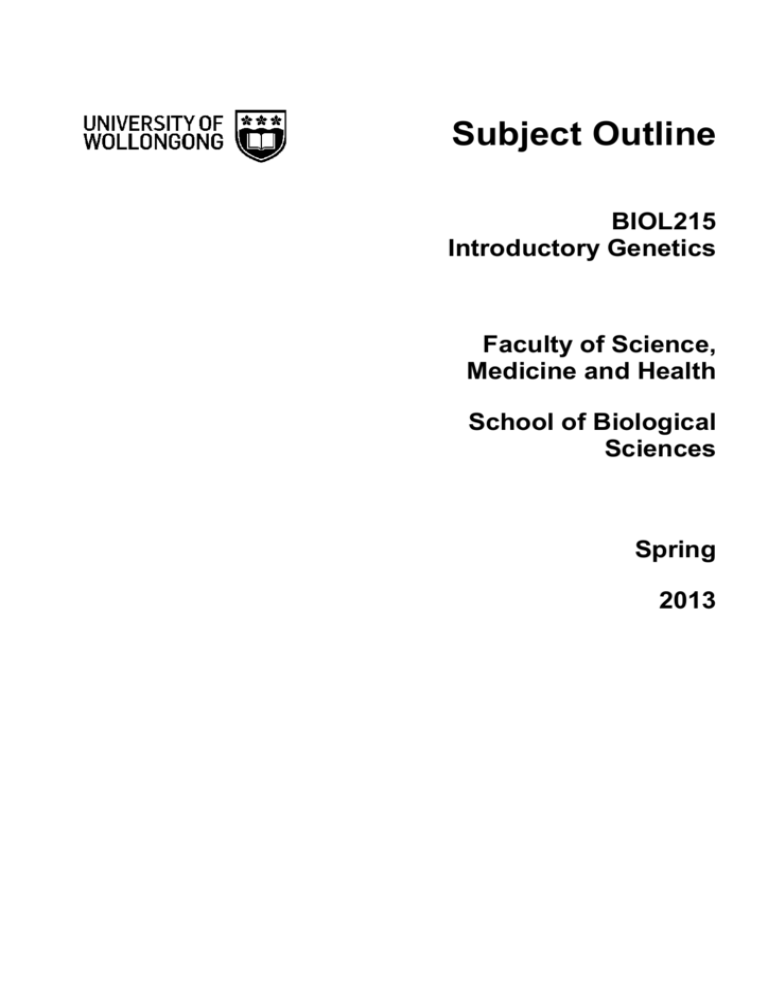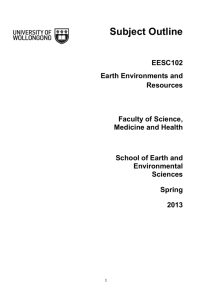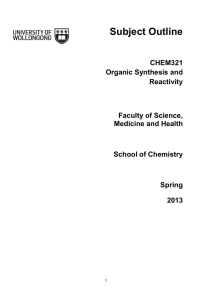
Subject Outline
BIOL215
Introductory Genetics
Faculty of Science,
Medicine and Health
School of Biological
Sciences
Spring
2013
Subject Outline
Subject code:
BIOL215
Subject name:
Introductory Genetics
Credit points:
6
Pre/co-requisites:
BIOL213
Mode of delivery:
On Campus
Delivery location:
Wollongong campus
Version history
5th edition
Ren Zhang, Faculty of Science, Health and Medicine, UOW
2013
4th edition
Ren Zhang, Faculty of Science, Health and Medicine, UOW
© University of Wollongong 2013. All rights reserved.
2009
Copyright and Disclaimer
No part of this work may be reproduced without the prior written consent of the University of Wollongong. All requests
and enquiries should be directed to the Vice-Principal (Administration), University of Wollongong, Northfields Avenue,
Wollongong NSW 2522 Australia. Within Australia telephone (02) 4221 3920; international +61 2 4221 3920.
http://www.uow.edu.au/about/disclaimer/index.html
The University of Wollongong attempts to ensure that the information contained here is correct at the time of
production, however, sections may be amended without notice by the University in response to changing
circumstances or for any other reason.
2
Contacts
Subject Co-ordinator
Name:
Location:
Phone:
Email:
Ren Zhang
35.103
4221 3427
rzhang@uow.edu.au
Faculty of Science, Medicine and Health
Location
41.152
Telephone
Email
4221 3492
smah_student_enquiries@uow.edu.au
Consultation mode and times:
_____________________________________________________________________
Lecturers
Dr Ren Zhang (Coordinator):
rzhang@uow.edu.au; Room 35.103; 42213427
Consultation time: Friday 10.30 – 12.30 am
Prof Mark Dowton:
mdowton@uow.edu.au; Room 35.G19; 42213013
Consultation time: Friday 1.30 – 3.30 pm
Dr Jason McArthur:
jasonm@uow.edu.au; Room 32.231; 42215650
Consultation time: By appointment
Dr Lezanne Ooi:
lezanne@uow.edu.au; Room 32.231; 42215865
Consultation time: By appointment
Technical Officer
Mr Alan Adolfsson:
alana@uow.edu.au; Room 41.179; 42213435
Demonstrators
Mr James Scifleet: jamess@uow.edu.au
Mr Simon Yang: yy083@uow.edu.au
Mr Nathan Ralston-Bryce: nrb699@uowmail.edu.au
3
Subject Information
Outline
This subject aims to provide an introduction to most of the main areas of knowledge within
the extremely broad discipline of genetics. An understanding of the various modes of
genetic inheritance, and their evolutionary consequences are fundamental to the
understanding of all other areas of biology.
The subject consists of an integrated series of lectures together with tutorial and practical
exercises, which have been selected to introduce some of the basic techniques employed in
genetic research. Further specialisation in several areas of genetics is possible within this
school through our third year (e.g. BIOL303, BIOL320, BIOL321), honours and
postgraduate courses.
The lectures will draw examples from a range of organisms. This is done to illustrate the
fact that the concepts and terminology of genetics are almost universally applicable, and to
illustrate the links between areas of genetics and other biological disciplines. You will be
encouraged to develop a specific area of interest in genetics (this is particularly true of the
oral tutorial presentation), but the assessment for this course will emphasise the need for
you to integrate material from the whole course.
The lecture material should be treated as a basic outline of each of the topics and will
normally include reference to texts and recent research papers. Tutorial sessions will follow
one of two formats: i.e. pre-lab tutorial or presentation/discussion of recent publications
from the genetics literature. Tutorials and practicals should be used as a forum for
discussion of any problems that you are having with the course.
Learning Outcomes
Through successful completion of this subject students will be able to:
1
Mechanisms of inheritance in a range of organisms.
2
Basic skills involved in microbial culturing, selection of mutations,
plasmid transfer and chromosome mapping of bacteria.
3
Simple applications of molecular biology.
4
The role of DNA, RNA and protein in cells.
5
The molecular basis of genetic and genotypic variation.
6
The mechanisms of genetic regulation.
4
Faculty Graduate Qualities
Valuable qualities gained by UOW graduates are essential for gaining employment and
making an important contribution to society and their chosen field – further information is
available at http://www.uow.edu.au/about/teaching/qualities/
Engagement in this subject will contribute to each student’s development of the following
UOW Graduate Qualities:
Informed
• Comprehensive knowledge of an area of Science and well-developed skills in using
relevant technologies
• Awareness of the international context in which advances in Science are made and
applied
Independent learners
• Critical thinking skills
• Scientific approach to the acquisition, analysis, and interpretation of data
Independence in seeking to extend knowledge through ongoing research, enquiry and
reflection
•
•
Problem solvers
Application of creative, logical and critical thinking to scientific problems
Effective communicators
• Well-developed written, oral & aural communication
• Effective collaboration and teamwork across a range of settings and cultures
Responsible
• Ethical decision making
• Respect for diverse opinions, professions, and cultures
Lecture/Tutorial/Laboratory Times
Lectures:
2 hours Thursday, 8.30 – 10.30 in 35-G20
Tutorials:
1 hour Thursday, 10.30 – 11.30 (all weeks) and Thursday 12.30 – 13.30 (week 1only) in 35G20
Practicals:
Thursday 13:30 – 16:30 in 41.G74
Study Time
Students should note that UOW policy equates 1 credit point with 2 hours of study per week
that includes lectures and tutorials. For example, in a 6 credit point subject, a total of 12
hours of study per week is expected.
5
Prescribed Reading
Russell, P.J. (2010) iGenetics (3rd Ed.), Benjamin Cummings
Recommended Readings
You will need to read widely to fully understand the material covered in this subject.
Recommended readings will be listed for each lecture (which should broaden your
understanding of the topic) and you are advised to read at least the basic reference before
the lecture (i.e. section of text book). Some of the fundamental theories and concepts of
genetics are adequately covered in a number of texts, but concepts in many areas are
rapidly evolving and are better studied through reference to recent journal articles. Your
written work must show evidence of your reading and, in the final examination, emphasis will
be placed on questions that test the breadth of your knowledge and your ability to integrate
the various sections of this course.
Many useful genetics texts, statistical texts, guides for scientific writing and a number of
useful journals are available in the library. Some of the reference books are listed below.
Essential texts, together with copies of some important articles, will be placed on
closed reserve or E-reading in the library.
nd
iGenetics (2 Ed.) /Peter J. Russell
Benjamin Cummings, 2006 576.5/5
Genetics / Peter J. Russell
New York, NY : HarperCollins Publishers, 1992, 1996, 1998, 575.1/113
Gene cloning and DNA analysis / Terry A. Brown
Malden, MA : Blackwell Science, 2001, 572.8633/6
The biology of plasmids / David K. Summers, Oxford ; Cambridge, Mass. : Blackwell
Science, 1996, 589.908732/1
Gene action : a historical account / Werner Mass New York ; Oxford : Oxford University
Press, 2001, 572.8609/1
The Mendelian revolution : the emergence of hereditarian concepts in modern science
and society / Peter J. Bowler
Baltimore : Johns Hopkins University Press, 1989, 575.109/6
Bacterial and bacteriophage genetics : an introduction / Edward A. Birge
New York : Springer-Verlag, c1988, 589.9015/5
An Introduction to genetic analysis 4th ed. / David T. Suzuki [et al.]
New York : W.H. Freeman, c1989, 575.1/111
Philosophy and revolutions in genetics : deep science and deep technology / Keekok
Lee
Houndmills, Basingstoke [England]; New York : Palgrave Macmillan, 2003, 576.5/10
6
The Power of bacterial genetics : a literature-based course / [edited by] Jonathan
Beckwith, Thomas J. Silhavy
Plainview, N.Y. : Cold Spring Harbor Laboratory Press, 1992, 589.9015/10
Trends in chromosome research / Editor: T. Sharma
New Delhi : Narosa; Berlin : Springer-Verlag [distributor], c1990,
574.87322/19
Genetics and society: a sociology of disease / Anne Kerr
New York : Routledge, 2004, 362.196042/5
A passion for DNA : genes, genomes, and society / James D. Watson ; introduction,
afterword, and annotations by Walter Gratzer
Cold Spring Harbor, N.Y.: Cold Spring Harbor Laboratory Press, c2001, 572.8/20
Reconfiguring nature: issues and debates in the new genetics / edited by Peter
Glasner
Aldershot, Hants, England : Ashgate, 2004, 599.935/5
Statistics books
Zar (1984) Biostatistical Analysis, 519.502547
Seigel (1956) Nonparametric Statistics, 300.182/10
Scientific writing
Royal Society of London (1974) General Notes on the Preparation of Scientific Papers,
808.0665/3
Lindsay (1984) A Guide to Scientific Writing. Longman-Cheshire, Melbourne, 808.0665/5
The recommended readings are not intended as an exhaustive list and students should use
the Library catalogue and databases to locate additional resources.
Materials for Practical Classes
You should bring the following to each practical class
(a) This manual.
(b) Calculator.
(c) Ruler, pen etc.
(d) Laboratory coat (essential in this subject).
Ethical Objection to the Use of Animal and Animal Products
In this subject, the use of animal tissues or animal-derived products (such as fly abdomens)
is inherent and unavoidable, in order to achieve specific learning objectives. Students with
conscientious objections to that use should not enrol in this subject.
Students who intend to avoid a particular learning activity on the basis of conscientious
objection should notify the subject coordinator in writing as early as possible, not later than
the end of Week 2 of the session.
For further information, refer to http://www.uow.edu.au/about/policy/UOW058708.html
7
e-Learning
This subject has an internet site: Moodle (choose BIOL215 once in the site). Please visit this
site frequently, as it will be updated during the session with course material, lecture notes,
pre-practical notes, practical results, additional resources and announcements about the
subject.
A
University
guide
to
eLearning
and
‘Netiquette’
http://www.uow.edu.au/student/elearning/guide/index.html
8
can
be
found
at
Lecture and Tutorial Schedule
Lectures: Thursday 8.30-10.30, 35.G45; Tutorials*: Thursday 10.30-11.30 35.G20
Date
Lecturer
Lecture Topic
Tutorial Topic
01 Aug
(RZ)
(MD)
Subject introduction
1. History: DNA as the genetic material
2. Meiosis and segregation
08 Aug
(MD)
3. Mendelian genetics
4. Non-Mendelian genetics
Working with GMOs
15 Aug
(RZ)
5. Prokaryote gene regulation
Tutorial seminars
Seminar preparation
Use of library*
6. lac and trp operons
22 Aug
(JM)
7. Plasmids
8. Viruses
Tutorial seminars
29 Aug
(LO)
3. Prokaryote transposons and integrons
4. Eukaryote transposons
Tutorial seminars
05 Sept
(LO)
11. Mutations in DNA
12. DNA repair and recombination
Tutorial seminars
12 Sept
(RZ)
13. Life cycle of bacteriophage
14. Lambda gene expression
Tutorial seminars
19 Sept
(RZ)
Mid-session assessment: 9.00 am 35.G20
Tutorial seminars
26 Sept
(LO)
15. Eukaryotic gene regulation
16. The genetic analysis of development
Tutorial seminars
Mid-session break (28th Sept-4th Oct)
10 Oct
(RZ)
17. Recombinant DNA technology
18. DNA cloning
Tutorial seminars
17 Oct
(JM)
19. Screening for recombinants
20. Applications of genetic engineering
Tutorial seminars
24 Oct
(RZ)
21. Recombinant proteins (1)
22. Recombinant proteins (2)
Tutorial seminars
31 Oct
(RZ)
23. Structural genomics
24. Functional genomics
*This tutorial on Use of library will take place at 12.30-13.30 in 35.G20.
MD: Mark Dowton; LO: Lezanne Ooi; JM: Jason McArthur; RZ: Ren Zhang
9
Practical Schedule
Thursday 13.30-16.30 41.G74
Week
Practicals
1
(MD)
Prac. 1
Use of library resources
2
(MD)
Prac. 2
Nature of genetic material
3
(RZ)
Prac. 3
Prac. 4
Aseptic techniques
Titration of bacteriophage T4
4
(JM)
Prac. 5
Introduction of lacZ regulation project
Transformation of E. coli with pREP4
Analysis of prac. 3 & 4 results
5
(LO)
Prac. 6
Isolation of plasmid DNA
and gel electrophoresis
Prac. 7
Induction and inhibition of lacZ expression
Results: electrophoresis of plasmid DNA
6
(LO)
7
(RZ)
Prac. 8
Galactosidase assay
Final result analysis – lacZ project
8
(RZ)
Prac. 9
Introduction of cloning project
Restriction digestion of lambda and pHSG398
DNA
Gel electrophoresis of digested DNA
Ligation of digested lambda and pHSG398 DNA
Prac. 10
Prac. 11
9
(LO)
Prac. 12
Transformation of E. coli
Analysis of prac 10 results
Mid-session break (24th Sept-1st Oct)
10
(RZ)
Prac. 13
Plasmid isolation from transformants
and gel electrophoresis
11
(JM)
Prac. 14
Restriction digestion of isolated plasmids
and gel electrophoresis
12
(RZ)
Sum of prac. 8 -14
Final result analysis – cloning project
***
10
Assessment
Minimum attendance requirements
Attendance to the practical and tutorial classes is compulsory. Failure to attend these
classes places an unfair strain on your fellow students when you are conducting group
activities. Thus, failure to attend or partial attendance of practical classes or tutorials without
an approved Academic Consideration based on medical certificate or other documentation
will result in the deduction of 10% from the final mark for each practical period for this
assessment item.
Minimum performance requirements
Students need to complete each component at the level specified.
Component
Final Examination (no matter what
your mark is prior to the exam)
All assessments combined (practical
worksheets, prac reports,
mid session quiz & final exam)
Minimum Standard
45%
50%
Students who do not meet the minimum performance requirements as set out in the Subject
Outline may be given a Fail grade or TF (Technical Fail) grade on their Academic Transcript.
See the General Course Rules at
http://www.uow.edu.au/handbook/generalcourserules/index.html
Summary
Task
Title
Practical worksheet
Mid-session quiz
Practical report 1
Practical report 2
Oral seminar
Final examination
Weighting
DNA material
4%
10%
18%
18%
10%
40%
lacZ expression
DNA clonging
Topics of genetics
Due Date
Week 4 before prac
Week 8 lecture class
Week 9 before prac
Week 14 Monday
Tutorial clases
Exam date
Mid-session quiz: multiple choice or short-answer questions.
Final exam: Short-answer and long-answer questions.
Performance grades
HD
High Distinction
85–100%
D
Distinction
75–84%
C
Credit
65–74%
P
Pass
50–64%
PS
Pass Supplementary
50%
F
Fail (unsatisfactory completion)
0–49%
TF
Technical Fail
No mark recorded
11
Scaling
Marks awarded for any assessment task (including examinations) may be subject to scaling
at the end of the session by the Unit Assessment Committee and/or the Faculty Assessment
Committee (FAC). Marks will only be scaled to ensure fairness/parity of marking across
groups of students. Scaling will not affect any individual student’s rank order within their
cohort. For more information refer to Assessment Guidelines – Scaling
http://www.uow.edu.au/about/policy/UOW058609.html
Submission and Return of Assessment Items
Practical worksheet and reports (hard copies) need to be submitted at SMAH Central. Each
assignment MUST have a SATS (Student Assignment Tracking System) coversheet
attached to the front of the assignment. Instructions for generating a coversheet can be
http://smah.uow.edu.au/currentfound
on
the
Science
Central
web
page:
students/UOW151958.html.
For an assignment to be successfully submitted at SMAH Central please note the
following:
•
The coversheet must be signed and dated
•
The assignment must have the correct coversheet i.e. the correct subject code
and tutorial group (if applicable)
•
A legible barcode with all numbers and digits below e.g. UOW20131007656
•
Assignments must be submitted by the indicated time on the due date
Properly submitted assignments will be acknowledged by email. If an assignment is
submitted to SMAH Central without any of the above we will contact you and advise that you
need to return to SMAH Central with the correct coversheet. Your assignment won’t be
recorded as being submitted until the correct coversheet is attached. This might mean that
the assignment is recorded as being submitted late.
Marked assignments will be returned through SMAH Central and students will be notified to
collect. Please note: uncollected assessment tasks will be destroyed 21 days after the
release of marks for the session.
Students are advised to keep an electronic or hard copy of all submitted assessment tasks
except in circumstances where this is not possible e.g. where the task is submitted at the
end of activity in which it was completed.
Late Submission
All assessment tasks are to be submitted on the due dates as specified in this Subject
Outline. Assessment tasks submitted late will be penalised by the deduction of 10% of the
maximum possible mark for the assessment task per calendar day or part thereof. Deduction
of marks will not result in a negative mark.
Note that assessment tasks submitted to SMAH Central must be submitted by 2:30 pm on
the due date to guarantee being recorded in SATS as being submitted on time.
12
Academic Consideration including Extensions of Time
Applications from students for academic consideration should be made only on the grounds
of serious or extenuating circumstances. Applications for academic consideration are
governed by the University’s Student Academic Consideration Policy at
http://www.uow.edu.au/about/policy/UOW058721.html
Do not assume that an application for special consideration will be automatically granted.
Supplementary Assessments
Supplementary assessment may be offered to students who receive a mark of 48% or 49%,
and are otherwise identified as meriting an offer of a supplementary assessment. The form
of supplementary assessment will be determined at the time the offer of a supplementary
assessment is made. For more information refer to the Supplementary Assessment
Guidelines
http://www.uow.edu.au/content/groups/public/@web/@gov/documents/doc/uow112335.pdf.
Note that if you are offered a supplementary examination as the supplementary assessment
that you will need to sit the examination in the supplementary examination period.
Referencing
The Harvard referencing system is used in BIOL215 – this is also known as the author-date
system due to the order of the information presented. Failure to document adequately and
fully is to ignore scholarly rules – and run the risk of plagiarism.
Please
consult
the
UOW
library
website
for
further
information:
http://public01.library.uow.edu.au/refcite/style-guides/html/
Plagiarism
Students are responsible for submitting original work for assessment, without plagiarising or
cheating, abiding by the University’s policy on plagiarism as set out in the University
Handbook under the University’s Policy Directory. Plagiarism has led to expulsion from the
University.
The University’s Academic Integrity and Plagiarism Policy, Faculty Handbooks and subject
guides clearly set out the University’s expectation that students submit only their own original
work for assessment and avoid plagiarising the work of others or cheating. Re-using any of
your own work (either in part or in full) which you have submitted previously for assessment
is not permitted without appropriate acknowledgement. Plagiarism can be detected and has
led to students being expelled from the University.
The use by students of any website that provides access to essays or other assessment
items (sometimes promoted as ‘resources’) is extremely unwise. Students who provide an
assessment item (or provide access to an assessment item) to others, either directly or
indirectly (for example by uploading an assessment item to a website) are considered by the
university to be intentionally or recklessly helping other students to cheat. This is considered
academic misconduct and students place themselves at risk of being expelled from the
University.
http://www.uow.edu.au/about/policy/UOW058648.html
13
Assessment
______________________________________________________________
Task 1:
Practical worksheet
Due:
Week 4 before prac class
Weighting: 4%
Details:
A series of questions that arise from observations and results obtained during practical 2 –
the Nature of Genetic Material. These should be completed both during the prac time, and
afterwards. Students are encouraged to use internet resources to answer some of the
questions.
Criteria for assessment:
Answers are marked as correct/incorrect.
Task 2:
Mid-session quiz
Due Date:
Lecture class week 8
Weighting: 10%
Details:
The material covered in lectures up to week 6 will be examined in the format of short answer
questions in the mid-session quiz. It will take 40 minutes in the lecture venue starting at 9.00
am. Students arriving late will not be able to sit for the quiz and will receive zero for this
assessment.
The mid-session quiz is designed to provide you with relevant examples of the type of
questions included in the final exam in this subject. These will allow you to become familiar
with the level of knowledge expected of you in the final exam.
Criteria for assessment:
Understanding of the lecture material; interpretation in writing of answers with illustrations,
as appropriate.
Task 3:
Oral seminar
Due Date: During session in tutorial classes
Weighting: 10%
Details:
Student groups of three (3) will be required to give a 10-minute tutorial seminar (followed by
2 minutes of questions) on an area relevant to molecular genetics. Tutorial talks will run
from week 3 to week 12 during the tutorial times. Students should choose their own tutorial
topic from recent (Jan. 2013 or later) publications in scientific journals. Topics must be
approved by a lecturer by presenting a photocopy of the selected journal article during
practical time. Each group should register for a presentation time for their tutorial topic with
the Technical Officer, by week 2. There will be a limit to the numbers of seminars, normally
four (4), for each tutorial timeslot depending on the total student numbers. Attendance at
each tutorial is compulsory. Failure to attend will result in a 10% per absence penalty on
your own tutorial mark. The principles to remember when you "plan" your tutorial
presentation and how your presentation will be assessed are outlined below.
Criteria for Assessment:
Introduction
•
Demonstrated sound knowledge of research area
•
Evidence of background library research
Aims
•
Clearly stated aims/hypotheses
Methods
•
Brief, concise description of how experiments were performed
Results
•
Summarised and displayed in a meaningful and comprehensible fashion
14
Discussion/Conclusions
•
Author's major points
•
Significance/evaluation of the work - “Critical” scientific approach
Handling of questions
•
Directly/concisely/confidently
•
Sound knowledge
Presentation
•
Presented in an accurate and easy-to-understand fashion
•
Fluency (flow) of seminar
•
Structure & organisation of seminar
•
Use of audio/visual aids
Task 4:
Due Date:
Weighting:
Practical report 1
Week 9 before prac class
18%
Task 5:
Practical report 2
Due Date:
Week 14 Monday
Weighting: 18%
Details:
There are two practical reports based on two projects during weeks 5 – 8 and 9 – 14,
respectively. Read the instructions below and Marking Schemes on later pages carefully
before writing up your reports!
Scientific writing may seem to have a strangely stilted style and format, but there are good
reasons for this. Ideally the use of a universal style and format makes it easier for the skilled
reader to extract as much or as little information as required simply by going to the
appropriate, concisely written sections.
The reports should be written following the format and style of papers published in the
journal: Archives of Microbiology (sample paper: Li et al. 2012 on the Library’s e-Readings
website for BIOL215). You don’t need to format two columns/page as the journal prints.
1.
Title
Give the report a concise but informative title.
2.
Abstract
This should be a brief summary of the experimental approach, major results and
conclusions (not more than 5% of the length of the report).
3.
Introduction
(i)
A description of the background to the studies that are being carried out, e.g.
this might include theoretical predictions and should include the reason for the
approach taken. You should refer to work done by other authors and cite
these in the text accordingly. Do not cite the manual as a text/source.
(ii)
A clear statement of your objectives.
4.
Materials and methods
You should cite the Subject Manual (Zhang et al. 2013). Do not duplicate the
instructions in the manual. Do, however, record any additional details or deviations
from the written procedure. These may be very important should the experiment give
an unexpected result.
15
5.
Results
(i)
Your results should include all relevant data. Your data should be presented in
the form of graphs and tables (take care not to present the same information in
more than one place). Each Figure or Table should have a detailed title that
makes it independent of the remainder of the report. All figures and tables
must have an appropriate number and be referred to in the written text of the
results.
(ii)
Your results section should include a written description of your data. You
must lead the reader through your interpretation and analysis of the data. Are
your hypotheses accepted or rejected? Why? What trends have emerged?
etc.
(iii) Where class results are collated during the class, these data may also be
presented and discussed in relation to your own results. If your own experiment
has failed, you should perform calculations using another group’s data. You
should clearly reference the use of other groups work appropriately.
6.
Discussion
Discussion and conclusions must follow logically from the results and must be clearly
and fully explained. Note: This is not the place to describe your results, refer to
tables or figures or introduce statistical tests (that's the function of your results
section). Be as concise as possible, but include any criticisms of procedures (if
appropriate) and explain the relationship between your conclusions and those
predicted from lectures or your reading. That is, you MUST refer to other relevant
materials and cite them as is appropriate.
7.
References
You should indicate all references to other people's work, conclusions or
methodology by reference to the relevant source i.e. books, scientific papers, the
laboratory manual (in methods section), etc. Use the format as given in the journal
of Archives of Microbiology.
8.
Appendix
This should include all raw data (where appropriate) and calculations.
PLEASE NOTE:
A MAXIMUM TEN-PAGE LIMIT (EXCLUDING REFERENCES AND APPENDIX)
FOR EACH REPORT IS TO BE ADHERED TO.
PAGES IN EXCESS OF TEN (10) WILL NOT BE MARKED.
THE MINIMUM FONT TO BE USED IS 12 POINT AND LINE SPACING MUST BE
1.5 SPACED. Table/Figure legends and reference list can be single-
spaced.
MAKE SURE YOU ATTACH THE CORRECT MARKING SCHEME AND
ASSIGNMENT COVER SHEET (SEE BACK OF THE MANUAL) TO THE FRONT
OF YOUR REPORT.
16
All worksheets/reports must be submitted to SMAH Central (building 41) on or before the
due date and time indicated above, unless approved by your lecturer or the subject
coordinator. There will be a penalty of 10% for each day after the deadline if a report is
submitted late.
YOU MUST ATTACH the appropriate Marking Scheme to your submitted practical
report (i.e Marking Scheme: lacZ gene regulation and Marking Scheme: DNA Cloning, for
the two Practical reports). These are at the back of this subject manual. You must also
attach an Assignment Cover Sheet to all three assignments, this you can print out by
following the instructions that are also at the back of this subject manual. This cover sheet
has a barcode that will track your assignment and send you a receipt by sols mail as a
record of your submission.
Criteria for assessment:
Look up the Marking Schemes at the back of this Manual.
Task 6: Final Theory Exam
Due Date: Exam Period
Weighting: 40%
Details:
The final examination will cover the lecture material over the whole subject, duration 3 hr.
There will be a combination of short-answer questions and long-answer questions. Some
example questions will be given during lectures.
Criteria for assessment:
Understanding of the lecture material; interpretation in writing of answers with illustrations,
as appropriate.
University Policies and Student Services
The Science Undergraduate Student Guide and information about University
policies and procedures including examination procedures can be found at
http://www.uow.edu.au/science/generaladvice/index.html
Code of Practice - Students
http://www.uow.edu.au/handbook/codesofprac/cop_students.html
Student Academic Grievance Policy
http://www.uow.edu.au/handbook/courserules/studacgrievpol.html
Acknowledgment Practice/ Plagiarism
http://www.uow.edu.au/handbook/courserules/plagiarism.html
Student Academic Consideration Policy
http://www.uow.edu.au/handbook/courserules/specialconsideration.html
Health and Safety
http://www.uow.edu.au/about/policy/ohs.html
Non-Discriminatory Language Practice and Presentation
http://staff.uow.edu.au/eeo/nondiscrimlanguage.html
Code of Practice - Teaching and Assessment
http://www.uow.edu.au/handbook/codesofprac/teaching_code.html
Student Services (Disability Liaison Officer, University Counsellors, Careers
Service)
http://www.uow.edu.au/student/services/
17
General Advice
Students should refer to the Faculty of Science, Medicine and Health website for information
on policies, learning and support services and other general advice.
Use of Electronic Devices in Timetabled Activites
Ensure that mobile phones are turned off or turned to silent before timetabled activities.
Electronic devices including mobile phones and portable MP3 players should not be
accessed during timetabled activities unless otherwise advised.
18






